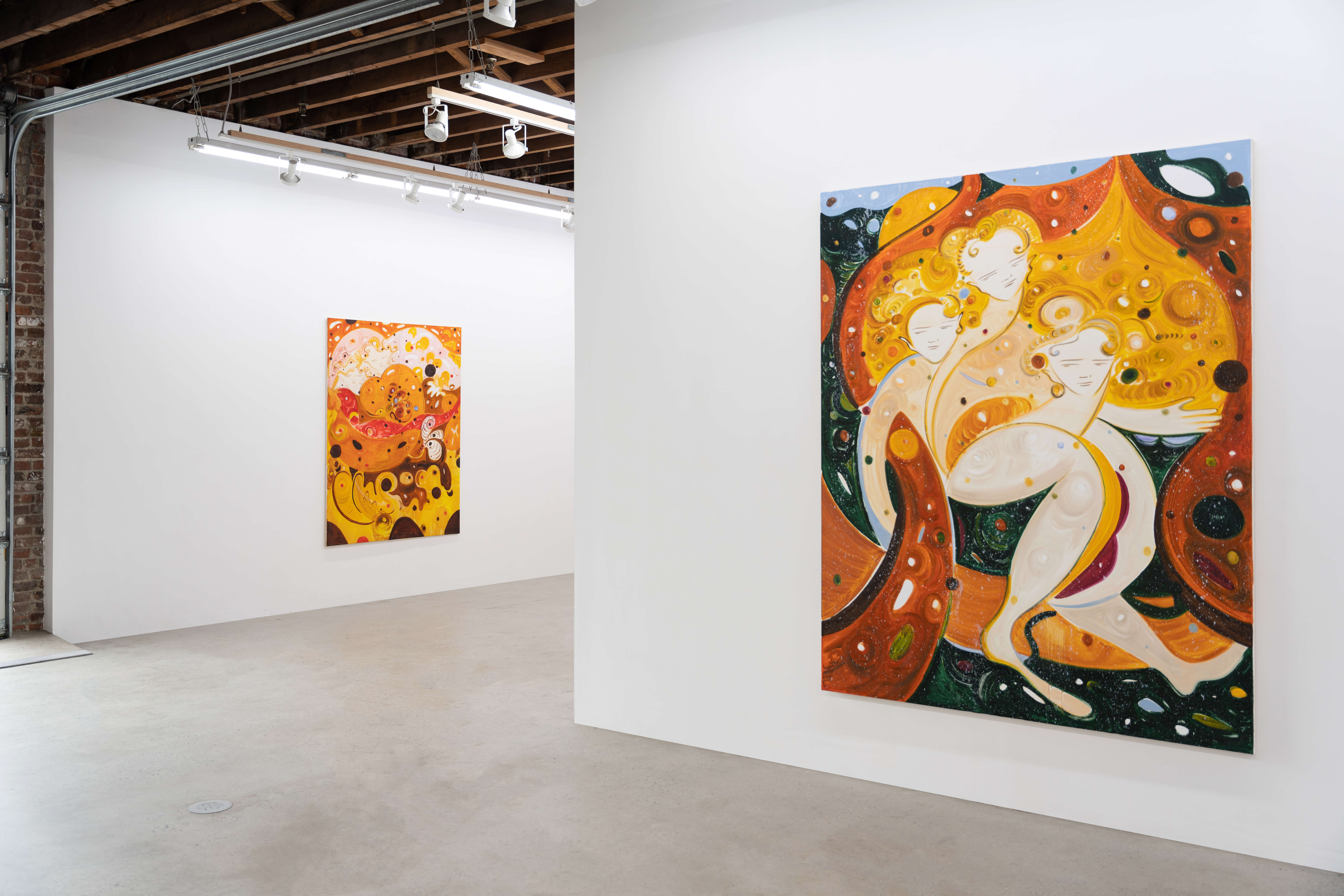In a joyous and colorful reimagination of Noah’s Ark, a vision for a new kind of Judaism
Yulia Iosilzon’s paintings transform Jewish symbols into a vibrant, morphing vision of the world

“Heaven’s Chambers” hung at the Carvalho Park gallery in Brooklyn. Courtesy of Carvalho Park
The art hanging in the airy Brooklyn gallery, Carvalho Park, is all about Noah’s Ark. But there’s none of the expected imagery: no bearded Noah, no looming waters, no pairs of animals marching onto a boat — in fact, there’s no boat at all.
Russian-born Israeli artist Yulia Iosilzon’s paintings are full of whimsy and joy. Her large canvases, many of which are painted onto transparent silk, are splashed with bright colors: golden yellows, bold blues, striking magentas.
And all of it is replete with Jewish symbolism, but it can be easy to miss if you don’t know the names of the pieces because she has transformed everything into something else. Each curl on her figures’ heads is a shofar. Three-petaled flowers evoke lobsters’ tails, a playful reference to the laws of kashrut. Her figures are multi-armed and -legged; in Jewish myth and text, ancient angelic giants walked the earth before the Flood.
There’s not even water — at least not exactly. Instead, the Flood is evoked through powerful swirls and serpentine lines, and the destruction wrought by the water comes through in an overlay of dots and flecks across each canvas, like the aftermath of an explosion.
But those same marks of debris can also feel like living things — leaves, microorganisms, the signs of new birth. Iosilzon painted the works while pregnant with her first child, and it’s easy to see the resonances that a tale of destruction, rebirth and transformation might have to someone growing a child.
In an inversion of the usual depictions of Noah’s Ark — fear, destruction, punishment — the dominating sense in Iosilzon’s paintings is life, not death.
In “Trees and Fruit from Mount Sinai,” the famously arid mountain — where Moses received the Ten Commandments after trudging for 40 years through the desert — abounds with greenery and trees. In Iosilzon’s imagining of the Flood, it has brought growth, not destruction.
For many secular Israelis, Judaism, stands for limits: no buses on Shabbat, no women in tallitot or tefillin, no mixed-gender prayer at the Western Wall, few non-kosher restaurants.
Iosilzon’s transformative vision of the story of Noah’s Ark feels like an attempt to offer an alternate Judaism, both to her fellow Jews and, perhaps, to her child. Iosilzon’s artwork imagines a world in which Jewish rituals and objects are transformative and life-giving, opening new possibilities instead of closing them off. Kashrut becomes a source of beauty. In the aftermath of the flood, her figures are morphing into new, magical forms, dancing and springing through her landscapes; they benefit from their relationship with God. The colors and emotions of each canvas are warm, enveloping and gleeful.
Yet Iosilzon is not breaking with Jewish tradition in the least — in fact, she’s participating in one of the most classic forms of Jewish exegesis: midrash.
The ancient style of interpretation, meant to reveal meanings below the surface, allowed rabbis to weave new mythologies into the text. Where a word is repeated or a verb tense is confusing, they asked why; in answering they often wrote an entire story, adding characters and plotlines to the biblical text. These interpretations, as fantastical as some may be, are just as much part of Judaism as the ironclad laws that some subscribe to.
Iosilzon’s works imagine a new Flood narrative, and with it, a new Jewish ethos — just as Jews have been doing for millennia.
A message from our CEO & publisher Rachel Fishman Feddersen
I hope you appreciated this article. Before you go, I’d like to ask you to please support the Forward’s award-winning, nonprofit journalism during this critical time.
We’ve set a goal to raise $260,000 by December 31. That’s an ambitious goal, but one that will give us the resources we need to invest in the high quality news, opinion, analysis and cultural coverage that isn’t available anywhere else.
If you feel inspired to make an impact, now is the time to give something back. Join us as a member at your most generous level.
— Rachel Fishman Feddersen, Publisher and CEO